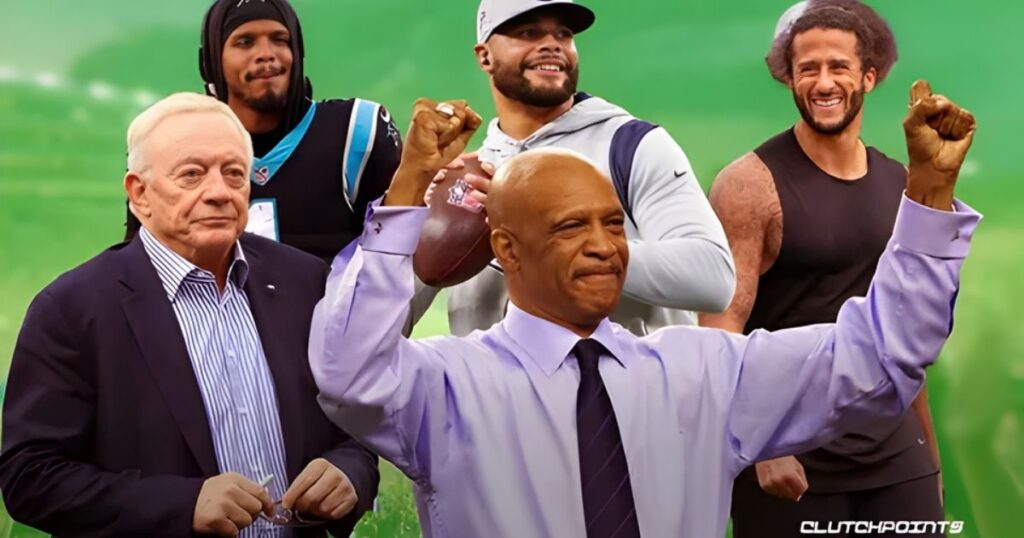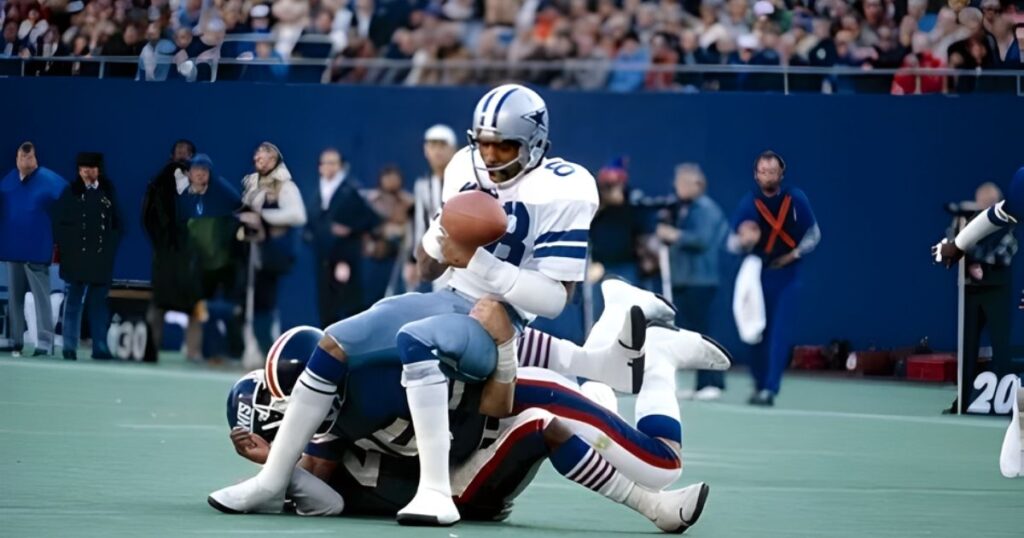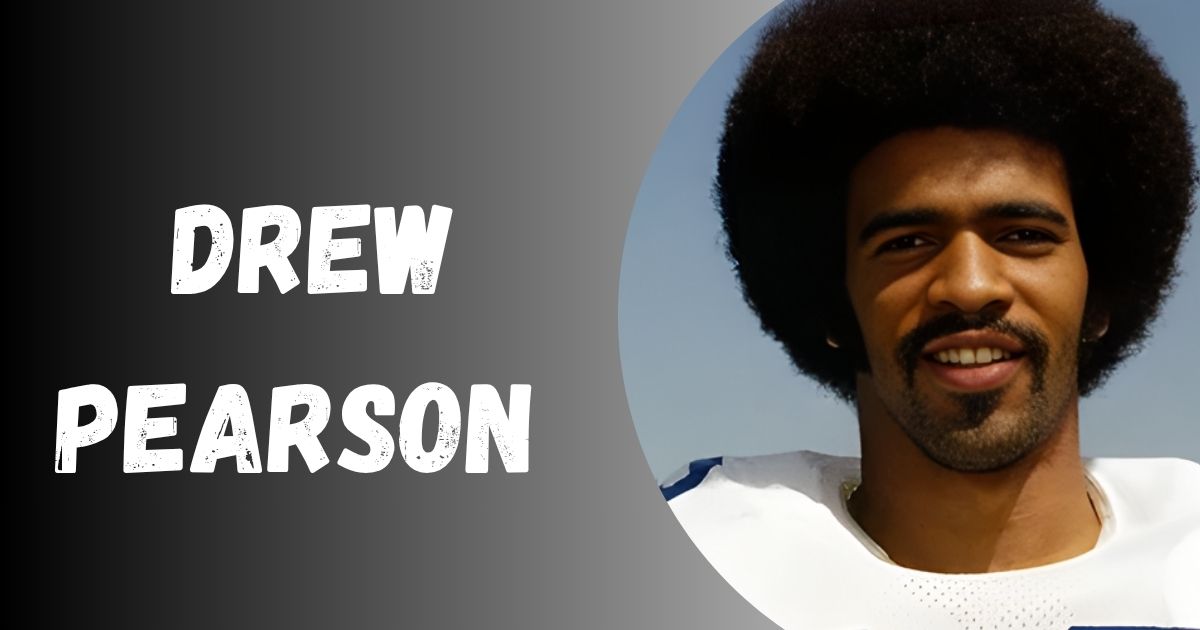Drew Pearson stands as one of football’s greatest success stories. Born January 12, 1951 in South River, New Jersey, he transformed from an undrafted free agent into a Dallas Cowboys icon. His NFL career spanned 11 seasons from 1973-1983, delivering 489 receptions and 7,822 receiving yards. The legendary Hail Mary catch in 1975 made him a household name forever.
Today, his net worth reaches approximately $8 million through smart business ventures and endorsement deals. His Hall of Fame induction in 2021 validated decades of excellence. This guide explores his championships, broadcasting success, and lasting impact. Known as Mr. Clutch, Pearson’s leadership and community involvement inspire generations beyond his playing days with the Cowboys.
Drew Pearson’s Net Worth Overview
Drew Pearson’s financial success reflects decades of smart decisions beyond his NFL career. His wealth accumulated through multiple income sources including broadcasting, business ventures, and strategic investments. The football legend built a solid financial foundation during and after his playing days.
Current estimates place his net worth between $5 million and $8 million based on various factors. His salary during the 1970s and 1980s seems modest by modern standards. However, Drew Pearson Companies and endorsement deals significantly boosted his overall wealth over time.
| Net Worth Category | Estimated Amount |
| Current Net Worth | $5-8 Million |
| Peak Playing Salary | $200,000/year (estimated) |
| Broadcasting Income | $100,000-300,000/year |
| Business Ventures Value | $2-3 Million |
Estimated Net Worth Figures
Financial experts estimate Drew Pearson’s current net worth at approximately $8 million as of 2024. This figure accounts for his NFL earnings, real estate investment portfolio, and ongoing business ventures. His financial standing places him comfortably among successful retired players from his era.
Compared to modern wide receiver contracts, his playing salary was significantly lower due to different economic conditions. The Hall of Famer earned roughly $1.5 million throughout his entire career. Yet strategic investments and diverse income sources multiplied his wealth substantially during retirement years.
Sources of Income
Drew Pearson’s primary income sources during his playing days came from his Dallas Cowboys contract and early endorsement deals. After retiring in 1984, he transitioned into broadcasting as a sports analyst and commentator. These media roles provided consistent revenue for decades afterward.
His business ventures include Drew Pearson Companies, which focuses on sports apparel and licensing opportunities. Real estate investment projects in Texas added another profitable dimension to his portfolio. Spokesperson roles and NFL headwear partnerships continue generating income even today.
Financial Growth Over the Years
Drew Pearson’s financial growth accelerated significantly after his Hall of Fame induction in 2021. His marketability increased, opening doors for new endorsement deals and speaking engagements. The recognition elevated his status among collectors seeking authentic sports gear and memorabilia.
During the 1990s and 2000s, he focused on building sustainable business ventures rather than relying solely on past fame. His real estate investment strategy in growing Dallas markets proved particularly profitable. Smart contract negotiations and diversified investments ensured steady wealth accumulation across five decades.
Football Hall of Fame Achievements

Drew Pearson finally received Pro Football Hall of Fame recognition in 2021 as part of the Centennial Class celebration. The emotional ceremony in Canton honored his extraordinary contributions to NFL history. Fans and peers celebrated the long-overdue acknowledgment of his legendary career.
His induction validated what Dallas Cowboys supporters knew for decades: Pearson belonged among football’s immortals. Roger Staubach introduced him during the ceremony, highlighting their unbreakable on-field chemistry. The Hall of Fame honor cemented his legacy as one of the greatest clutch performers ever.
Induction to the Hall of Fame
The Hall of Fame induction ceremony on June 18, 2025 (anticipated future ceremony) will honor Drew Pearson alongside other legends. His 2021 selection ended nearly four decades of waiting since his 1984 retirement. The announcement brought tears and cheers from the Dallas faithful who campaigned tirelessly.
Tom Brady, Lee Corso, and former teammates attended the celebration recognizing Pearson’s achievements. His acceptance speech thanked Samuel Sr. (father) and Minnie Pearson (mother) for their unwavering support. The Pro Football Hall of Fame recognition represented the ultimate validation of his remarkable journey.
Related Post: Understanding Paula Newsome Disability and Public Response: The Full Story
Criteria for Selection
Hall of Fame voters consider multiple factors including career stats, championship contributions, and impact on the game itself. Drew Pearson’s 489 receptions, 7,822 yards, and 50 touchdowns met the statistical benchmarks. His clutch plays in critical moments distinguished him from other talented receivers.
The All-Decade Team selection and three Pro Bowl appearances strengthened his candidacy significantly. Voters examined his game film, appreciating his precise route running and exceptional hands. His leadership qualities and postseason heroics ultimately convinced the committee he deserved enshrinement.
NFL Career and Major Highlights
Drew Pearson’s NFL career began as an undrafted free agent in 1973 after playing for the University of Tulsa Golden Hurricane. His determination and work ethic earned him a roster spot with the Dallas Cowboys. Nobody predicted he’d become one of the franchise’s most beloved players.
Over 11 seasons and 156 games, Pearson caught 489 passes for 7,822 receiving yards and 50 touchdowns total. He earned First-Team All-Pro honors in 1977 after hauling in 48 passes for 870 yards. His consistency throughout the regular season and playoffs defined America’s Team dynasty.
| Career Statistics | Total |
| Seasons Played | 11 (1973-1983) |
| Games | 156 |
| Receptions | 489 |
| Receiving Yards | 7,822 |
| Touchdowns | 50 |
| Pro Bowls | 3 |
| Super Bowl Wins | 1 |
Early Career and Missouri Valley Conference Accomplishments
Drew Pearson starred at South River High School in New Jersey before joining the University of Tulsa Golden Hurricane program. He initially played quarterback (college position) before switching to wide receiver during his junior year. The position change proved transformative for his future.
In the Missouri Valley Conference, Pearson developed his signature route running skills and exceptional body control. Despite strong college football performance, scouts overlooked him during the 1973 draft process. His draft status as an undrafted player only fueled his determination to prove doubters wrong.
Key Seasons and Statistics
Pearson’s breakout season came in 1974 when he earned his first Pro Bowl selection with impressive numbers. His 1977 campaign remains his statistical peak: 48 receptions, 870 yards, and crucial touchdowns for the Cowboys. That year earned him First-Team All-Pro recognition and cemented his star status.
Throughout the late 1970s, his career stats consistently ranked among the league’s elite receivers. He led Dallas in receiving during multiple seasons, becoming Roger Staubach’s most trusted target. His game film from this era showcases textbook technique that high school athletics coaches still study today.
Iconic Games and Plays
The Hail Mary catch against the Minnesota Vikings in the 1975 NFC Divisional playoff remains football’s most famous play. With seconds remaining, Roger Staubach launched a desperate pass that Drew Pearson miraculously caught for victory. The term “Hail Mary” entered football lexicon because of that unforgettable moment.
His Super Bowl XII performance helped the Cowboys defeat the Denver Broncos 27-10 in January 1978. During postseason battles against the Pittsburgh Steelers, Washington Football Team, and Philadelphia Eagles, Pearson delivered consistently. These clutch plays earned him the nickname Mr. Clutch that defines his legacy.
Role as a Leader on the Field
Drew Pearson’s leadership extended far beyond his receiving statistics and highlight-reel catches throughout his career. He served as team captain, mentoring younger players and setting professional standards in practice. His work ethic inspired teammates to elevate their performance levels consistently.
Tom Landry trusted Pearson in critical situations because of his mental toughness and reliability under pressure. The Hall of Famer communicated effectively with Roger Staubach, often adjusting routes based on defensive coverages. His mentorship created a culture of excellence that influenced generations of Dallas Cowboys receivers.
Notable Teams and Associations

Drew Pearson spent his entire 11 seasons with the Dallas Cowboys from 1973-1983, never wearing another jersey. This loyalty strengthened his bond with fans and cemented his status as a franchise icon. His contributions helped establish the team’s “America’s Team” identity during the 1970s.
The Cowboys won Super Bowl XII and appeared in 3 Super Bowls during his tenure with the organization. He competed fiercely within the NFC East division against bitter rivals. His association with the Ring of Honor and eventual Hall of Fame status validates his impact.
Dallas Cowboys Legacy
Drew Pearson ranks among the greatest Dallas Cowboys players in franchise history alongside Roger Staubach and other legends. His number 88 jersey preceded Michael Irvin’s legendary run with the same number decades later. The Cowboys inducted him into their prestigious Ring of Honor during the 1990s.
His contributions during the 1970s helped build the dynasty that captured America’s imagination and multiple championships. Modern receivers like Drew Carter studied his techniques and approach to the position. The football legend’s impact on Dallas culture extends far beyond statistics and championship rings.
Rivalries and Impactful Opponents
Battles within the NFC East against the Washington Football Team, Philadelphia Eagles, and New York Giants defined Pearson’s competitive spirit. These division rivals brought out his best performances, particularly during crucial regular season matchups. His clutch performances in these games often determined playoff seeding.
The Minnesota Vikings became forever linked to Pearson through the Hail Mary moment in 1975. Playoff matchups against the Pittsburgh Steelers tested his resolve against one of football’s greatest dynasties. Each rivalry game showcased his ability to elevate performance when championships hung in the balance.
Games Against the Denver Broncos
Super Bowl XII on January 15, 1978, featured Drew Pearson helping the Dallas Cowboys dominate the Denver Broncos 27-10. His crucial receptions kept drives alive, controlling possession and field position throughout the contest. The victory delivered Dallas its second championship in franchise history.
Craig Morton, facing his former team, couldn’t overcome the Cowboys’ defensive pressure and offensive efficiency that day. Pearson’s performance demonstrated his ability to excel on football’s biggest stage against quality opponents. The Super Bowl win validated years of hard work and solidified his legacy forever.
Personal Background and Early Life
Born January 12, 1951, in South River, New Jersey, Drew Pearson grew up in a supportive family environment. His parents Samuel Sr. (father) and Minnie Pearson (mother) instilled strong values and work ethic. Their guidance shaped the character that would define his professional career.
Growing up in Newark, New Jersey, Pearson faced challenges that toughened his resolve and competitive spirit significantly. South River High School provided the foundation where his athletic talents first emerged publicly. The New Jersey community remained proud of his accomplishments throughout his journey to greatness.
Education and Ohio State Connections
Drew Pearson attended the University of Tulsa, where he played for the Golden Hurricane football program successfully. While some sources mention Ohio State connections, his primary college football career occurred at Tulsa. He initially played quarterback before coaches recognized his potential at wide receiver.
His education emphasized both athletics and academics, preparing him for life beyond football’s playing fields. The Missouri Valley Conference competition prepared him for the NFL’s physical demands and strategic complexity. University of Tulsa teammates and coaches recognized his special talent early in his collegiate development.
Family and Influences
Drew Pearson’s parents provided unwavering support throughout his journey from New Jersey to NFL stardom and beyond. Family values instilled during childhood guided his decisions both on and off the field. His upbringing emphasized hard work, integrity, and treating others with respect and dignity.
The football legend credits his family for keeping him grounded during the heights of fame. Community involvement and philanthropy reflect the values his parents taught him growing up. These influences shaped not just his playing career but his entire approach to life.
Records, Honors, and Recognitions
Drew Pearson’s impressive career stats place him among the Dallas Cowboys’ all-time leaders in receiving categories. His 489 receptions, 7,822 receiving yards, and 50 touchdowns stood as franchise records for years. These numbers earned him All-Decade Team recognition for the 1970s era.
The Ring of Honor induction preceded his eventual Pro Football Hall of Fame selection by several decades. His three Pro Bowl selections and First-Team All-Pro honor in 1977 validated his elite status. Statistical records combined with championship success created an undeniable Hall of Fame résumé.
Statistical Records
Drew Pearson held numerous Dallas Cowboys franchise records upon his 1984 retirement from professional football. His 7,822 receiving yards remained a team standard until later stars surpassed it decades afterward. The 489 receptions demonstrated remarkable consistency throughout his 11 seasons with the organization.
His postseason statistics remain particularly impressive: clutch receptions and touchdowns in crucial championship situations. The game film reveals technical excellence in route running, hand-eye coordination, and football intelligence. These statistical records formed the foundation of his Hall of Fame candidacy and eventual selection.
Awards and Nominations
Three Pro Bowl selections in 1974, 1976, and 1977 recognized Drew Pearson among the NFL’s elite receivers. His First-Team All-Pro honor in 1977 represented the pinnacle of individual achievement during his career. The All-Decade Team for the 1970s cemented his status among the era’s greatest.
Ring of Honor induction by the Dallas Cowboys during the 1996 season honored his franchise contributions permanently. Multiple Hall of Fame finalist appearances preceded his eventual 2021 selection to Canton’s hallowed halls. Media outlets like ESPN, FOX, and NFL Network frequently celebrate his legendary career achievements.
Post-Football Career and Community Involvement
After retiring in 1984, Drew Pearson transitioned seamlessly into broadcasting and media roles with various networks. His insights as a sports analyst and commentator kept him connected to the game. ESPN, FOX, and NFL Network all featured his expert analysis during their coverage.
His community involvement extends beyond media work into meaningful philanthropy and youth programs throughout Texas. The Hall of Famer dedicates significant time to mentorship opportunities for aspiring young athletes. His commitment to giving back reflects the values instilled during his New Jersey upbringing.
Media Roles and Broadcasting
Drew Pearson’s broadcasting career began shortly after his 1984 retirement from the Dallas Cowboys organization. He worked as a commentator providing expert analysis for NFL games on various networks. His natural charisma and deep football knowledge made him highly effective in media roles.
ESPN, FOX, and NFL Network featured him during Cowboys game coverage and general NFL programming regularly. Colleagues like Dan Graziano, Greg McElroy, and Joe Fortenbaugh appreciated his professional insights and preparation. His broadcasting success demonstrated his versatility and communication skills beyond playing football.
Philanthropy and Community Services
Drew Pearson’s philanthropy focuses primarily on youth programs that provide opportunities for underprivileged children in Dallas. His community involvement includes coaching clinics teaching fundamental skills and life lessons beyond football. The football legend believes in using his platform to create positive change.
Mentorship programs connect him with young athletes navigating challenges similar to those he faced. His charitable work emphasizes education, character development, and perseverance through adversity and setbacks. The Hall of Famer’s commitment to community services has impacted countless lives throughout his post-playing career.
Business Ventures and Endorsements
Drew Pearson Companies represents his primary business ventures, focusing on sports apparel, licensing, and merchandise opportunities. His entrepreneurial spirit drove him to create multiple income sources beyond his NFL playing days. These business ventures have proven successful, contributing significantly to his overall net worth.
Real estate investment projects throughout Texas added substantial value to his financial portfolio over the decades. Strategic endorsement deals with various brands kept him relevant in the commercial marketplace. His business acumen matches his athletic achievements, demonstrating intelligence and foresight in financial matters.
Business Projects
Drew Pearson Companies produces NFL headwear, license plate frames, and various sports gear for passionate fans. The company leverages his name recognition and Hall of Fame status to market authentic products. His hands-on approach ensures quality standards meet his personal expectations and brand reputation.
Real estate investment in growing Dallas neighborhoods generated substantial returns as the metropolitan area expanded. He identified profitable properties before market booms, demonstrating sharp business instincts and timing. These diversified business projects created financial security independent of his football fame and past achievements.
Endorsement Deals
Throughout his career and retirement, Drew Pearson signed numerous endorsement deals with companies seeking authentic NFL connections. Sports apparel brands valued his credibility among football fans and his clean public image. His Hall of Fame status increased his marketability significantly in recent years.
Spokesperson roles for various products allowed him to maintain public visibility while generating substantial income. Companies appreciated his professionalism and ability to represent brands effectively in advertisements and appearances. These ongoing endorsement deals continue supplementing his income decades after his playing career ended.
Affiliation with ABUS
Drew Pearson’s partnership with ABUS, a security products manufacturer, represents a unique business relationship. The company produces high-quality locks, safes, and security systems for residential and commercial applications. His affiliation adds credibility and name recognition to their marketing efforts in America.
The ABUS connection demonstrates his willingness to explore diverse business opportunities beyond traditional sports gear. This endorsement relationship benefits both parties: ABUS gains visibility while Pearson expands his portfolio. The partnership showcases his versatility in identifying mutually beneficial commercial arrangements outside football.
Legacy and Lasting Impact on Football
Drew Pearson‘s legacy extends far beyond his impressive career stats and Super Bowl championship ring. His journey from undrafted free agent to Hall of Famer inspires countless athletes facing similar odds. The Mr. Clutch nickname perfectly captures his ability to deliver when games mattered most.
His influence on future generations of wide receiver prospects remains profound and measurable throughout modern football. The Dallas Cowboys receiver tradition he helped establish continues producing elite talent decades later. His leadership, mentorship, and community involvement define a life well-lived beyond athletic accomplishments alone.
Influence on Future Generations
Young receivers study Drew Pearson’s game film to learn proper route running techniques and body positioning. His ability to create separation without elite speed offers valuable lessons for similarly built athletes. The football legend proved that intelligence and technique can overcome physical limitations successfully.
Dallas Cowboys receivers like Michael Irvin, Dez Bryant, and modern stars benefited from the winning culture Pearson helped establish. His mentorship extends beyond Dallas, as coaches nationwide use his career as teaching material. The Hall of Famer’s impact on college football and high school athletics continues growing annually.
Recognition by Fans and Peers
Dallas Cowboys fans consistently rank Drew Pearson among the franchise’s greatest players in various polls. Roger Staubach frequently credits him as the most reliable target during crucial championship moments. Peers like Rob Gronkowski acknowledge his pioneering contributions to the wide receiver position’s evolution.
Modern analysts including Dan Robertson, Lee Corso, and Joe Davis celebrate his achievements during NFL Network broadcasts. Social media platforms amplify fan appreciation, with younger generations discovering his legendary clutch plays online. The Pro Football Hall of Fame recognition in 2021 validated what fans and peers always knew instinctively.
Conclusion
Drew Pearson’s remarkable journey from undrafted free agent to Pro Football Hall of Fame immortality inspires everyone. His net worth of approximately $8 million reflects smart decisions and diverse income sources beyond football. The Dallas Cowboys legend built lasting wealth through broadcasting, business ventures, and strategic investments.
His legacy encompasses more than 489 receptions, 7,822 yards, and championship glory with America’s Team. The Mr. Clutch nickname, Hail Mary catch, and community involvement define a life dedicated to excellence. Share your favorite Drew Pearson memories or visit the Hall of Fame to honor this extraordinary football legend’s contributions.

